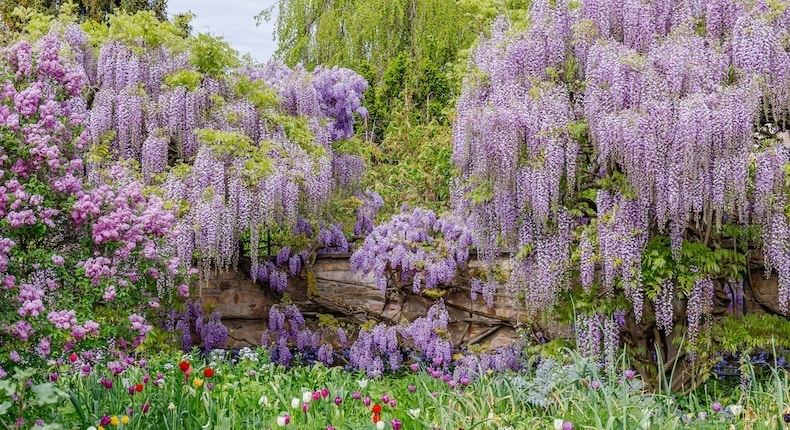
A Beginner’s Guide to Creeper Plants Example and Care Tips for Beginners. Creeper plants, also known as climbing plants or vines, are a fantastic addition to any garden or indoor space. Their versatility and beauty make them perfect for beginners who want to add some greenery to their surroundings. This guide will introduce you to some popular creeper plants and provide easy care tips to help you get started.
1. Popular Creeper Plants for Beginners

There are many types of creeper plants that are ideal for beginners due to their low maintenance and hardiness.
- Pothos (Epipremnum aureum): Also known as Devil’s Ivy, Pothos is an easy-to-grow plant that thrives in various conditions. Its trailing vines and heart-shaped leaves make it a popular choice for both indoor and outdoor spaces.
- English Ivy (Hedera helix): English Ivy is a hardy plant that can grow in low light conditions. It’s perfect for covering walls, fences, or as a ground cover.
- Sweet Potato Vine (Ipomoea batatas): Known for its vibrant foliage, Sweet Potato Vine comes in various colors like green, purple, and bronze. It’s great for hanging baskets or ground cover.
- Jasmine (Jasminum spp.): Jasmine is cherished for its fragrant flowers. It’s a beautiful climbing plant that can enhance any garden or indoor space with its delightful aroma.
- Morning Glory (Ipomoea purpurea): Morning Glory is famous for its beautiful, trumpet-shaped flowers that open in the morning. It’s a fast-growing vine that can quickly cover trellises and fences.
2. Benefits of Creeper Plants
Creeper plants offer a range of benefits that make them a great choice for beginners.
- Aesthetic Appeal: Creeper plants can transform any space with their lush greenery and beautiful flowers. They can be used to cover unsightly walls, fences, or structures, adding a natural touch to your environment.
- Air Purification: Many creeper plants, such as Pothos and English Ivy, are known for their air-purifying qualities. They can help remove toxins from the air, making your living space healthier.
- Privacy and Shade: Creeper plants can provide privacy by covering fences and walls. They can also create shaded areas in your garden, making it a more comfortable space to relax.
- Erosion Control: When planted on slopes or embankments, creeper plants can help prevent soil erosion by stabilizing the soil with their extensive root systems. (Read More: Top 10 Must-Have Car Accessories for Every Road Trip).
3. Basic Care Tips for Creeper Plants

Caring for creeper plants is relatively easy, making them perfect for beginners. Here are some basic care tips to help you keep your plants healthy and thriving. (Read More: Top Innovations in Automotive Paint: What’s Trending in 2024?).
- Light: Most creeper plants prefer bright, indirect light. However, some, like English Ivy, can tolerate lower light conditions. Make sure to place your plants in a spot where they can get the right amount of light.
- Watering: Creeper plants generally prefer well-draining soil and regular watering. It’s essential to keep the soil moist but not waterlogged. Overwatering can lead to root rot, so be mindful of your plant’s water needs.
- Fertilizing: Fertilize your creeper plants every few weeks during the growing season (spring and summer) with a balanced, water-soluble fertilizer. This will provide the necessary nutrients for healthy growth.
- Pruning: Regular pruning helps to keep your creeper plants healthy and encourages new growth. Remove any dead or yellowing leaves and trim back any overgrown vines to maintain the plant’s shape and size.
4. Common Issues and Solutions

Even with the best care, creeper plants can face some common issues. Here are a few problems and their solutions.
- Pests: Common pests like aphids, spider mites, and mealybugs can affect creeper plants. To control these pests, regularly inspect your plants and use insecticidal soap or neem oil if necessary. (Read More: Top 5 Lucite Car Lamp Designs Transforming Vehicle Aesthetics in 2024).
- Diseases: Fungal diseases like powdery mildew can occur in creeper plants. Ensure good air circulation around your plants and avoid overhead watering to prevent these diseases.
- Leggy Growth: If your creeper plants are becoming leggy, it may be due to insufficient light. Move your plants to a brighter location and trim back the overgrown vines to encourage bushier growth.
Conclusion article A Beginner’s Guide to Creeper Plants Example and Care Tips for Beginners
In conclusion, creeper plants are an excellent choice for beginners due to their versatility, beauty, and low maintenance. By selecting the right plants and following these simple care tips, you can enjoy the many benefits that creeper plants offer. Whether you’re looking to enhance your indoor space or create a lush garden, creeper plants can help you achieve your green thumb goals. So, get started with these easy-to-grow plants and watch your space transform into a green oasis.







